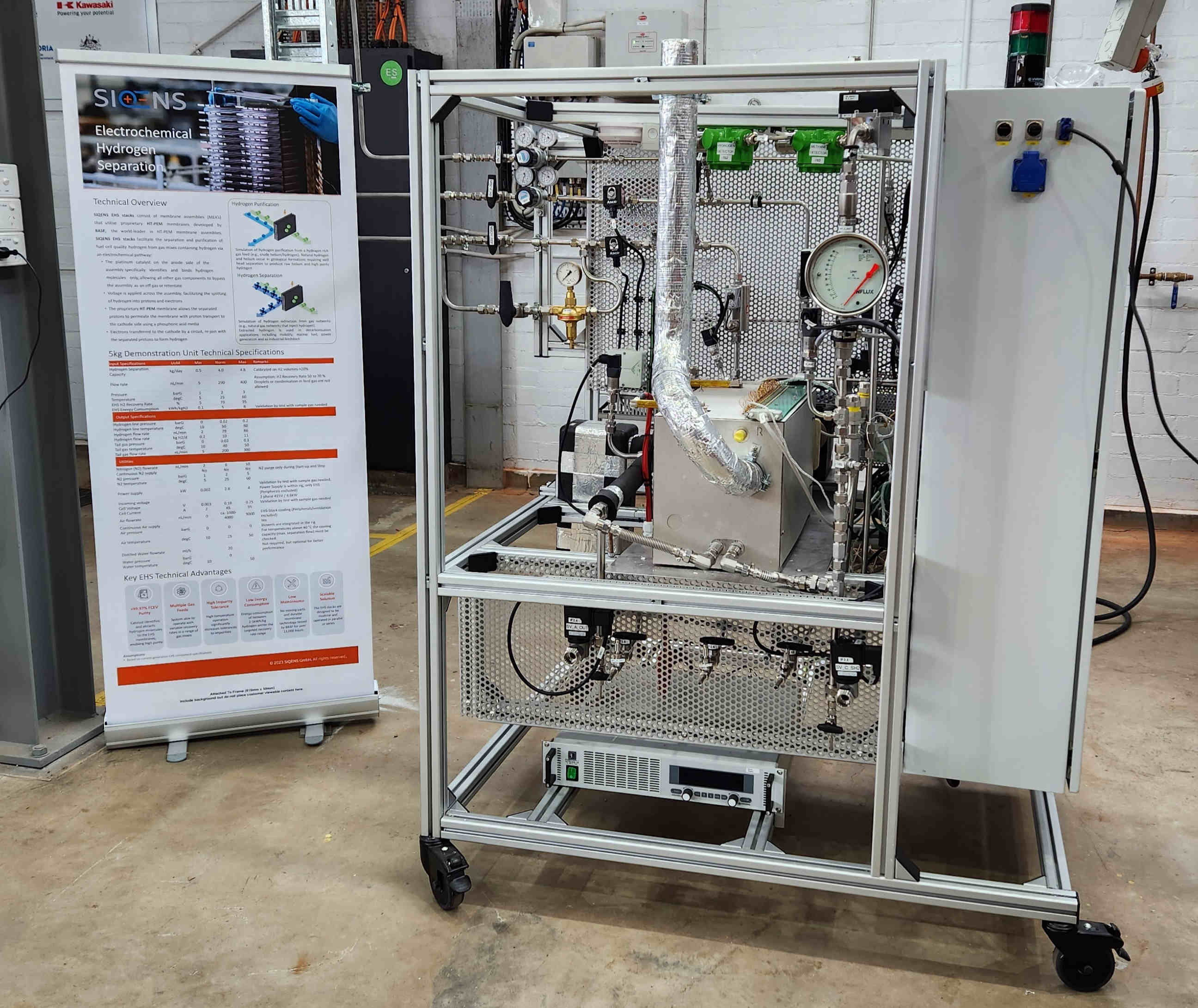SIQENS GmbH is a German company that produces fuel cells (which use hydrogen to generate electricity) and hydrogen gas separation solutions. Their electrochemical hydrogen separation systems can separate hydrogen from other gases, achieving the purity and quality suitable for hydrogen fuel cells to run.
Australian representatives of SIQENS have been following the country’s interest in geological hydrogen – hydrogen that is produced naturally underground. Geological hydrogen is often found together with helium. Both gases are valuable, but need to be separated. So SIQENS saw an opportunity to demonstrate the efficiency of their hydrogen separation systems for the nascent Australian geological hydrogen industry.
Demonstrating hydrogen technology in Australia
 Having worked with CSIRO before, SIQENS decided to use our Hydrogen Technology Demonstration Facility (HTDF) to test and demonstrate their electrochemical hydrogen separation rig.
Having worked with CSIRO before, SIQENS decided to use our Hydrogen Technology Demonstration Facility (HTDF) to test and demonstrate their electrochemical hydrogen separation rig.
“We wanted to demonstrate our hydrogen separation technology in Australia because of the country’s natural hydrogen industry, and CSIRO’s global reputation for solid science made the HTDF the easy choice”, explained Matthew Purcell, Project Manager for SIQENS.
The HTDF provides a safe and well-provisioned environment for researchers, industry partners and businesses to scale, test and demonstrate new and emerging technologies across the hydrogen value chain. It has the ability to handle commercial-scale gas flows, including gas detection and safety protocols.
Demonstrating SIQENS hydrogen separation technology
With the help of the CSIRO team, Matthew set up the SIQENS hydrogen separation rig in the HTDF, with a mixture of hydrogen and helium as input. He put the rig through its paces with hydrogen-helium mixtures ranging from 10% to 75% hydrogen, to assess its performance in separating the gases under different conditions.
The CSIRO team applied their gas handling expertise to facilitate the project, and conducted a Hazard and Operability Study (HAZOP) to ensure that the research adhered to rigorous safety standards, an essential step when working with high-purity hydrogen.
“It worked from Day One. We showed that the rig can produce up to 4.7kg of fuel cell quality hydrogen per day, which is much higher volumes than had previously been demonstrated. This success underscores the potential for scaling up hydrogen production in both commercial and industrial settings,” Matthew said.
Importantly, Matthew was able to show potential collaborators how the technology works.
“The HTDF is great for collaboration between science and industry. We were able to bring visitors from industry and government sectors in to see our technology working. In fact 25 different organisations came to see our rig”, Matthew said.
Following this successful demonstration, the SIQENS team is working with Australian industry partners on next steps.
SIQENS GmbH is a German company that produces fuel cells (which use hydrogen to generate electricity) and hydrogen gas separation solutions. Their electrochemical hydrogen separation systems can separate hydrogen from other gases, achieving the purity and quality suitable for hydrogen fuel cells to run.
Australian representatives of SIQENS have been following the country’s interest in geological hydrogen – hydrogen that is produced naturally underground. Geological hydrogen is often found together with helium. Both gases are valuable, but need to be separated. So SIQENS saw an opportunity to demonstrate the efficiency of their hydrogen separation systems for the nascent Australian geological hydrogen industry.
Demonstrating hydrogen technology in Australia
Having worked with CSIRO before, SIQENS decided to use our Hydrogen Technology Demonstration Facility (HTDF) to test and demonstrate their electrochemical hydrogen separation rig.
“We wanted to demonstrate our hydrogen separation technology in Australia because of the country’s natural hydrogen industry, and CSIRO’s global reputation for solid science made the HTDF the easy choice”, explained Matthew Purcell, Project Manager for SIQENS.
The HTDF provides a safe and well-provisioned environment for researchers, industry partners and businesses to scale, test and demonstrate new and emerging technologies across the hydrogen value chain. It has the ability to handle commercial-scale gas flows, including gas detection and safety protocols.
Demonstrating SIQENS hydrogen separation technology
With the help of the CSIRO team, Matthew set up the SIQENS hydrogen separation rig in the HTDF, with a mixture of hydrogen and helium as input. He put the rig through its paces with hydrogen-helium mixtures ranging from 10% to 75% hydrogen, to assess its performance in separating the gases under different conditions.
The CSIRO team applied their gas handling expertise to facilitate the project, and conducted a Hazard and Operability Study (HAZOP) to ensure that the research adhered to rigorous safety standards, an essential step when working with high-purity hydrogen.
“It worked from Day One. We showed that the rig can produce up to 4.7kg of fuel cell quality hydrogen per day, which is much higher volumes than had previously been demonstrated. This success underscores the potential for scaling up hydrogen production in both commercial and industrial settings,” Matthew said.
Importantly, Matthew was able to show potential collaborators how the technology works.
“The HTDF is great for collaboration between science and industry. We were able to bring visitors from industry and government sectors in to see our technology working. In fact 25 different organisations came to see our rig”, Matthew said.
Following this successful demonstration, the SIQENS team is working with Australian industry partners on next steps.
